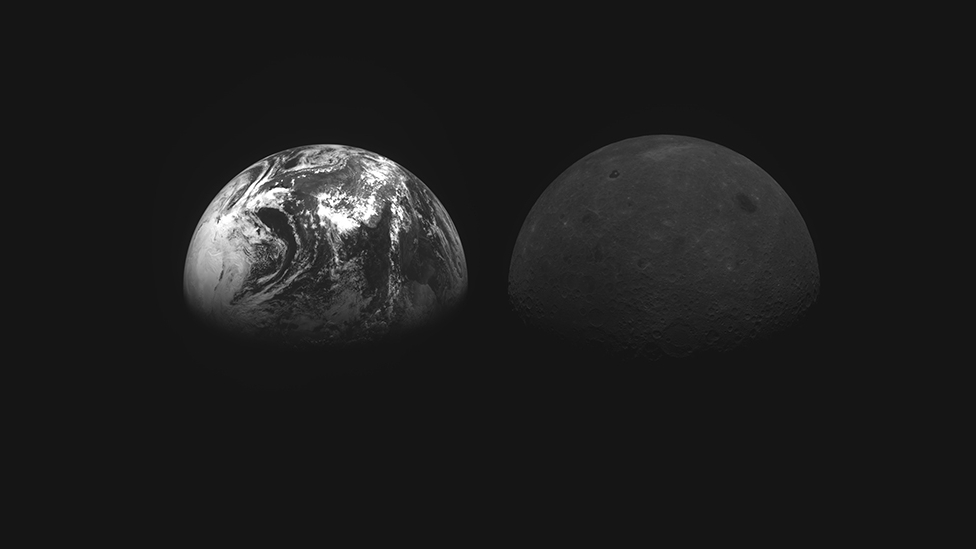South Korea's 1st moon probe Danuri begins to enter lunar orbit
The Korea Pathfinder Lunar Orbiter entered lunar orbit Friday (Dec. 16) after a four-month voyage.

Danuri, South Korea's first deep-space exploration mission, is finally arriving at the moon after a four-month voyage.
The Danuri spacecraft was expected to begin entering lunar orbit at on Friday (Dec. 17) at 2:45 p.m. EST (1945 GMT, 2:45 a.m. Dec. 17 in South Korea), according to a statement from the Korea Aerospace Research Institute (KARI). The maneuver, the first of five planned engine burns through Dec. 28 to refine Danuri's orbit around the moon, will clear the way for the probe to get started on its lunar science objectives.
Danuri, also known as the Korea Pathfinder Lunar Orbiter (KPLO), began its long and circuitous journey to the moon on Aug. 4, launching on a SpaceX Falcon 9 rocket from Florida's Cape Canaveral Space Force Station. The moon probe has traveled over 3.3 million miles (5.4 million kilometers) on its journey so far, KARI officials have said.
Related: Every mission to the moon (reference)
The successful launch put Danuri into a ballistic lunar transfer orbit, which took the probe on a 134-day-long, looping, fuel-efficient voyage through Earth-moon space. It finally entered a polar lunar orbit with a target average altitude of 60 miles (100 kilometers) above the lunar surface.
The 1,495-pound (678 kilograms) KPLO is South Korea's first exploration mission to go beyond Earth orbit. That $180 million mission is ambitious; Danuri packs six separate science payloads designed to gather data for a range of science objectives. Five of those instruments — a terrain imager, a Wide-Angle Polarimetric Camera, magnetometer, gamma-ray spectrometer and a new networking technology test payload — were developed by Korean universities and research organizations.
NASA also has a presence on board in the form of the sixth payload: a highly sensitive camera named ShadowCam that's designed to scope out permanently shadowed regions at the lunar poles for hints of water-ice deposits. Data from the instrument could be helpful for NASA's Artemis program, which aims to create a sustainable human presence on the moon.
Get the Space.com Newsletter
Breaking space news, the latest updates on rocket launches, skywatching events and more!
After its first maneuver to enter orbit, Danuri is expected to follow it up with four more during moon approaches on Dec. 21, Dec. 23, Dec. 26 and Dec. 28 before settling into a final orbit on Dec. 29, KARI wrote in a statement. All of those dates are in local time for South Korea.

KPLO is part of growing international interest in and activity at the moon. For example, Danuri reached the moon a month after the arrival of NASA's CAPSTONE cubesat. The agency's Artemis 1 mission successfully launched to lunar orbit and saw the Orion spacecraft return to Earth during the time Danuri was en route to the moon.
Danuri also marks the first step toward even grander lunar ambitions for South Korea, which also envisions a robotic moon landing around 2032 and a mission to Mars in 2045.
Follow us on Twitter @Spacedotcom or on Facebook.
Join our Space Forums to keep talking space on the latest missions, night sky and more! And if you have a news tip, correction or comment, let us know at: community@space.com.

Andrew is a freelance space journalist with a focus on reporting on China's rapidly growing space sector. He began writing for Space.com in 2019 and writes for SpaceNews, IEEE Spectrum, National Geographic, Sky & Telescope, New Scientist and others. Andrew first caught the space bug when, as a youngster, he saw Voyager images of other worlds in our solar system for the first time. Away from space, Andrew enjoys trail running in the forests of Finland. You can follow him on Twitter @AJ_FI.
-
VK30 Great article with nice links to read more, thanks. I'd wondered what happened since launch.Reply









